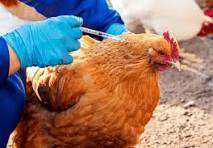How to Recognize and Treat Common Chicken Diseases
Raising healthy chickens is both rewarding and essential for anyone in backyard poultry or small-scale farming. But like all animals, chickens are vulnerable to diseases that can spread fast if not recognized early. In this post, we'll walk you through the most common chicken diseases, how to spot the symptoms, and what you can do to treat and prevent them—naturally and effectively.
Whether you’re a seasoned poultry keeper or just starting out, this guide will help you protect your flock and keep them clucking happily.
Why Chicken Health Matters
Healthy chickens lay better eggs, grow faster, and save you money on vet bills. More importantly, quick recognition of disease signs prevents outbreaks, especially in close-knit flocks. Plus, some chicken diseases can spread to other animals—or even humans.
Common Chicken Diseases and How to Spot Them
1. Marek’s Disease
Symptoms:
🐔 Paralysis in legs or wings
🐔 Weight loss despite normal appetite
🐔 Grey iris or blindness
🐔 Tumors under the skin
Treatment:
There’s no cure, but vaccination at birth is highly effective. Keep your coop clean and dry to reduce risk.
2. Coccidiosis
Symptoms:
🐔 Bloody or watery diarrhea
🐔 Droopiness or weakness
🐔 Loss of appetite
🐔 Pale combs
Treatment:
Coccidiosis is caused by parasites in dirty bedding or wet conditions. Use medicated chick starter feed, and treat with Amprolium (Corid) in water if diagnosed. Clean bedding frequently to prevent reinfection.
3. Respiratory Infections (CRD, Infectious Bronchitis)
Symptoms:
🐔 Sneezing or coughing
🐔 Nasal discharge
🐔 Swollen eyes or sinuses
🐔 Rattling breathing
Treatment:
Isolate sick birds immediately. Treat with antibiotics like Tylosin (with vet advice) and ensure good ventilation in the coop. Herbal remedies like oregano oil or garlic can support immune health naturally.
4. Fowl Pox
Symptoms:
🐔 Scabby lesions on combs, wattles, or beak
🐔 Loss of appetite
🐔 Decreased egg production
Treatment:
This viral disease spreads via mosquitoes. There’s no direct cure, but affected chickens usually recover. Use iodine or antiseptic on lesions and boost immunity with vitamin A supplements. Prevent future cases with vaccination and mosquito control.
5. Egg Binding
Symptoms:
🐔 Hen appears weak or fluffed up
🐔 Straining with no egg
🐔 Swollen abdomen
🐔 Lameness or penguin-like stance
Gently soak the hen in warm water for 20 minutes to relax muscles. Massage the abdomen and offer calcium supplements. If the egg doesn’t pass, see a vet immediately—it can be fatal.
Tips for Preventing Chicken Diseases
1. Keep the Coop Clean: Remove droppings and replace bedding regularly.
2. Fresh Water and Balanced Feed: Nutrient-rich diets boost immunity.
3. Isolate New Birds: Quarantine new chickens for 2 weeks.
4. Regular Health Checks: Look for signs of distress or unusual behavior.
5. Vaccinate When Possible: Especially for diseases like Marek’s and Fowl Pox.
When to Call a Vet
If more than one bird is affected, symptoms are severe, or you’re unsure of the cause—don’t wait. Call a vet who specializes in poultry. Early intervention saves lives and prevents flock-wide outbreaks.
Final Thoughts
Caring for chickens comes with responsibility, but it doesn’t have to be overwhelming. By learning to recognize early signs of illness, treating appropriately, and maintaining a clean, stress-free environment, you can raise a thriving, disease-free flock.
A little daily attention goes a long way. Stay observant, act quickly, and your chickens will reward you with eggs, companionship, and peace of mind.

